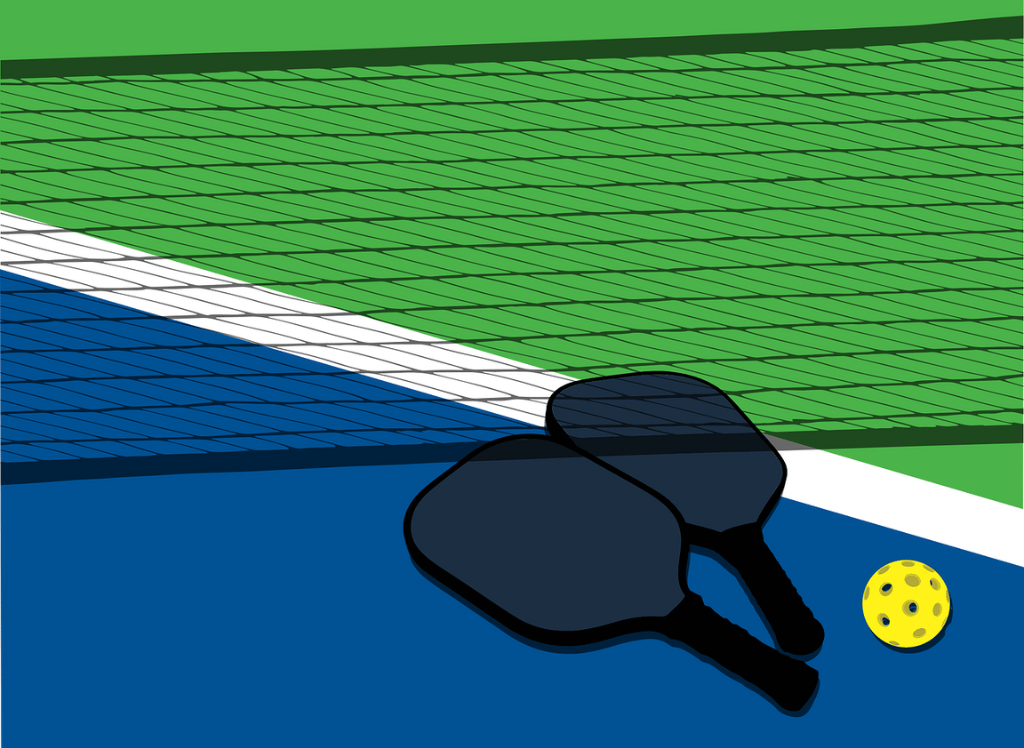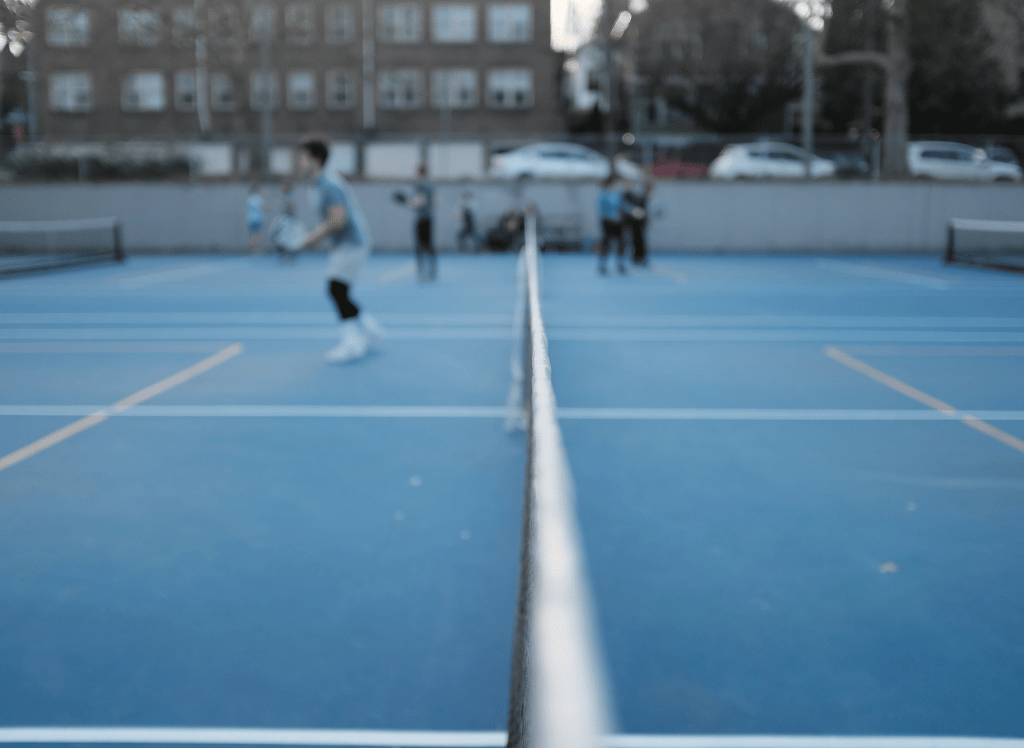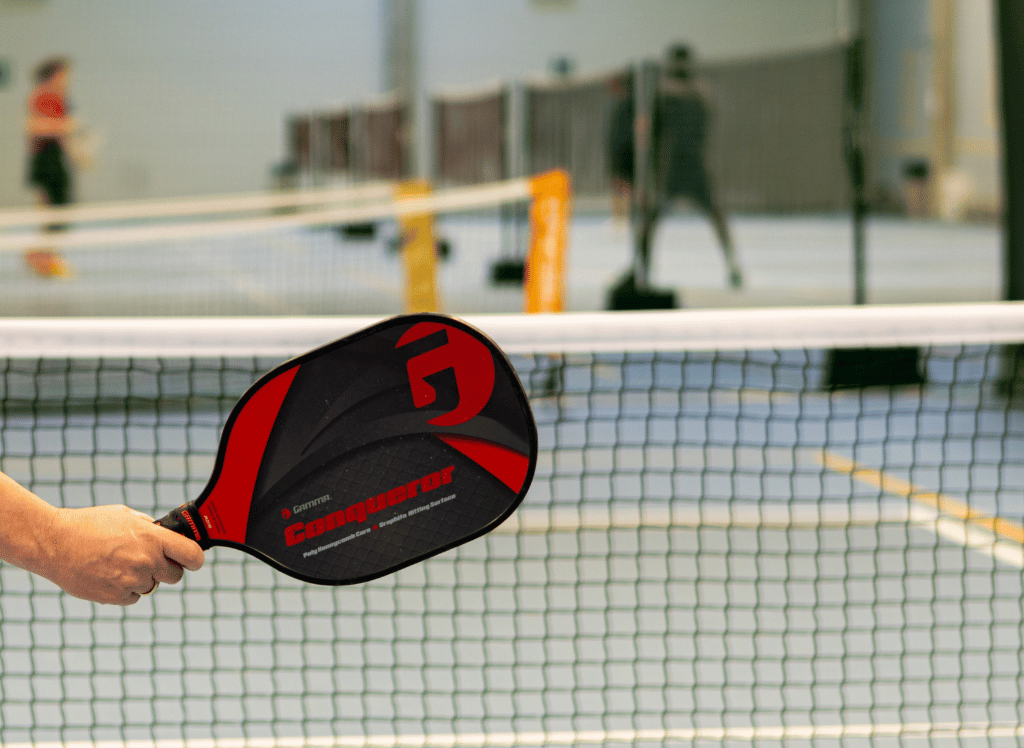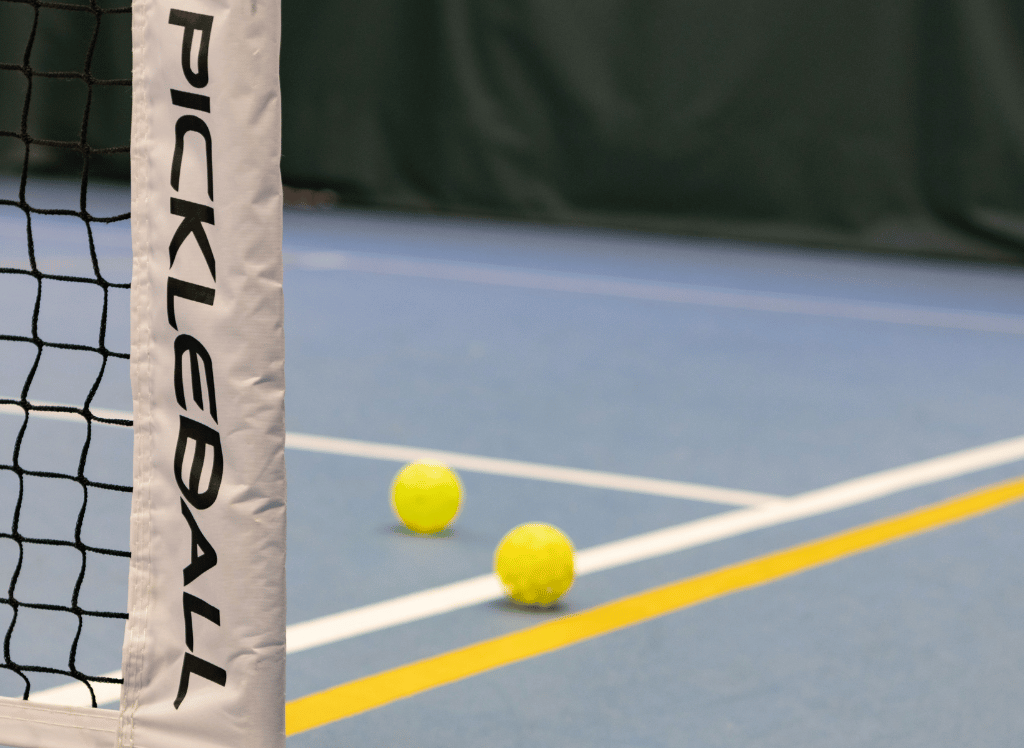Have you ever found yourself in the middle of a thrilling pickleball game, only to be baffled by the scoring system? You are not alone. Mastering the pickleball scoring system is essential to fully enjoy and excel in this exciting sport. In this comprehensive guide, we will unravel the mysteries of the scoring system, discuss serving rules, advanced strategies, and present essential tips for beginners and novice players on how to keep score in pickleball. By the end of this journey, you’ll be one step closer to becoming a pickleball pro.
Keys
- Master the fundamentals of pickleball scoring, which is played to 11 points and uses rally scoring.
- Understand player positioning, serving rules & dynamics for singles & doubles play.
- Call score before serves for fairness and practice strategies like stacking & hacks to improve performance!
Pickleball Scoring Fundamentals
Players of all levels must grasp the basics of pickleball scoring. A smooth and enjoyable experience, whether in doubles or singles, hinges on knowing how to keep score in pickleball. In pickleball, each game is played to 11 points, with rally scoring used, meaning a point is awarded after each rally, no matter who served. A win requires a lead of at least two points, ensuring a competitive and engaging game.
But how does the scoring system differ between doubles and singles games? In doubles scoring, there are three numbers, whereas in singles scoring, there are only two. The scoring system is as follows:
- The first number represents the serving team’s score
- The second number represents the receiving team’s score
- In doubles, the third number indicates the server number (either 1 or 2)
With these basics in mind, let’s dive deeper into the differences between doubles and singles scoring.
The Three Numbers in Doubles Scoring
The three numbers in the scoring system have a significant role in doubles pickleball. The first number represents the serving team’s score, the second number represents the opposing team’s score, and the third number indicates which server on the team currently has the serve, either 1 or 2. For example, if the team’s score is 5-3 with Server 1 serving, it would be written as 5-3-1.
At the beginning of each game, the first team that’s serving will only do it once, meaning only the serving team has a chance to score during the first serve of the game, and that’s when the serving team scores. If a team messes up their serve, Server 2 takes over from the right side of the court. If they mess up again, the opponents get to serve, and the serving team loses their turn, called a side-out. This process directly impacts the serving team’s score.
Singles Scoring Simplified
Compared to doubles, singles pickleball scoring is somewhat simpler. In singles, there are only two numbers representing each player’s points. The first number denotes the server’s score and the second number represents the receiver’s score. This is the basic outline of the pickleball scoring system in singles play.
As for serving, you don’t have to worry about remembering any server numbers in singles play. You simply need to serve from the right side of the court when your score is even, and from the left side when your score is odd. With this basic understanding of singles scoring, you’re well on your way to confidently tackling any pickleball match.
Serving Rules and Player Positioning
Serving rules and player positioning hold prominence in the pickleball game, irrespective of whether you’re playing doubles or singles. In doubles, the player on the right side of the court always serves first. Each player gets to serve at least once, and if your team scores a point, you can continue serving. However, if you make a fault, it’s your partner’s turn to serve. The server number helps keep track of which player is serving.
In singles play, the serving rules and positioning slightly differ. To serve, you need to stand on the right side of the court when your score is even and on the left side when your score is odd. In both doubles and singles, serves must be made diagonally to the opposing player’s court, ensuring a fair and challenging experience for all players involved.
Doubles Serving Dynamics
Grasping the serving dynamics in doubles pickleball is key to success. Every player on a team has an opportunity to serve. The first and second server can be identified by the third number of the score. The player who started the game on the right side of the court is always the first server.
When the serving team wins a point, they switch sides on the court, with the server moving from the right side to the left side, and the partner moving from the left side to the right side. If the serve goes out, it’s a fault. This means the other team gets a side-out and their turn to serve.
Singles Serving Guidelines
The serving guidelines in singles pickleball differ slightly from doubles play. To serve, you must stand on the correct side of the court based on your score: right side when your score is even and left side when your score is odd. The serve must be made diagonally to the opposing player’s court.
If a fault occurs during the serve, such as serving out-of-bounds or into the net, the serve goes to the other player. By adhering to these guidelines, you ensure fair play and an enjoyable experience for both players.
Calling and Verifying the Score
To prevent confusion and errors during the game, calling and verifying the score is paramount in pickleball. The score should be called when all players are in the correct position and ready to play. The serving team calls the score first, followed by their opponents, and finally, the server in the rotation calls the score.
Failing to call the score before taking the third shot of the rally results in a fault. If you realize you didn’t call the score, players can stop play and ask for the correct score to be re-called. Proper score calling and verification ensure a smooth and fair game for all players involved.
When to Call the Score
For a well-organized game in pickleball, it’s key to know when to call the score. The score should be called when both the server and the receiver are in the right positions and ready to play. By calling the score before the serve, you make sure the score is tracked accurately, and the game remains fair for all players.
In addition to maintaining a fair and organized game, calling the score before the serve also helps prevent premature serves and ensures all players are prepared for the upcoming rally. This simple yet crucial step can significantly enhance the overall enjoyment of the game for all participants.
Rectifying Incorrect Score Calls
If the score called is incorrect, correcting the mistake is crucial for ensuring a fair and enjoyable game. The server has the right to recall the score before the receiving team hits the ball. If needs be, the correct receiving team’s score can then be called and the serve can be repeated. However, if the play is interrupted and the server had called the correct score, the player who stopped play will be the one to fault and forfeit the rally.
When in doubt, it’s best for players to stop play and ask for the correct score to be re-called. By addressing incorrect score calls promptly, you can ensure a fair and accurate game for all players involved.
Advanced Strategies: Stacking and Hacks
Those aspiring to improve their pickleball game can significantly enhance their court performance by employing advanced strategies such as stacking and serving position hacks. Stacking in doubles pickleball is a strategy where both players on a team line up on the same side of the court before a serve or during the game. This tactic can provide strategic advantages, such as better court positioning and communication with your partner.
In addition to stacking, implementing hacks for serving positions can also help improve your game. Serving from the middle, back, or side of the court are all great strategies to create an advantage for your team and make it harder for the other team to return the serve. By incorporating these advanced strategies, you’ll be well on your way to mastering the art of pickleball.
Stacking in Doubles Pickleball
Teams can maximize their strengths and minimize weaknesses through strategic stacking in doubles pickleball. By lining up on the same side of the court before a serve or during the game, teams can gain better court positioning and enhance communication between partners. Stacking is often done when one partner has more skill or experience than the other.
This strategy allows the more experienced player to cover a larger portion of the court and make it more difficult for the opposing team to score points. By effectively using stacking in doubles pickleball, your team can gain a competitive edge and improve overall performance.
Pickleball Hacks for Serving Positions
In addition to stacking, players can benefit from mastering hacks for serving positions. One such hack is the “even right, odd left” rule, which applies to both singles and doubles play. This rule helps players remember their serving position based on their score. When the player who started the game on the right side of the court is back on the right side again, their team’s score will always be even.
By utilizing these hacks for serving positions, players can ensure they’re always in the correct position to serve, ultimately improving their chances of winning points and gaining an advantage over their opponents.
Tournament Play and Scoring Variations
Scoring variations and rules in pickleball may differ between tournament play and recreational play. Tournaments usually set the winning score at 15 or even 21 points, as opposed to the standard 11 points. This change in winning scores can add an extra layer of challenge to the game, requiring players to adapt their strategies and maintain focus for a longer duration.
Additionally, interactions with referees during tournament play may differ, as players are only allowed to ask certain questions related to the score and how to determine the correct score when on the court. By familiarizing yourself with these variations, you can be better prepared to excel in tournament play.
Winning Scores in Tournaments
The winning scores in pickleball tournaments often differ from standard games. While a typical pickleball game is played to 11 points, tournament matches can be played as a single game to 15 points, a game to 21 points, or best 2 out of 3 games to 11 points. The winner is determined by the number of games won, adding an extra layer of challenge and excitement to the competition.
Adapting to these different winning scores requires players to maintain concentration and adjust their strategies accordingly. By doing so, you’ll be better equipped to tackle the unique challenges presented by tournament play and ultimately improve your overall performance.
Permitted Questions and Referee Interactions
Interactions with referees during tournament play are confined to particular questions and situations pertaining to scoring. If the serving team or receiving team inquires after the serve is hit, the referee will disregard the questions. Should a team repeatedly ask questions to slow down or disrupt the game, the referee may issue a technical warning.
It’s essential to respect the referee’s decisions and maintain good sportsmanship throughout the game. By adhering to these guidelines, players can ensure a fair and enjoyable tournament experience for all participants.
Tips for Beginners and Novice Players
Beginner or novice players should practice and learn from experience to hone their pickleball scoring skills. Some important aspects to focus on include:
- Calling the score when serving
- Using court position to keep track of the game
- Maintaining good sportsmanship and etiquette, such as respecting opponents’ line calls and appealing to the referee when necessary
By mastering these skills, you can have an enjoyable and rewarding game of pickleball.
Whether you’re a beginner or a seasoned player, there is always room for improvement. By focusing on these essential tips and strategies, you’ll be well on your way to becoming a formidable competitor on the pickleball court.
Practice Makes Perfect
As the saying goes, practice makes perfect. Honing your pickleball scoring abilities through practice and learning from experience are essential for growth and improvement. Repetition and drills can help beginners learn the right form, refine their technique, and become more comfortable on the court. Practice sessions also provide an opportunity to identify and rectify mistakes, allowing players to develop their skills and perform better in games.
When serving, calling the score out loud ensures all players are aware of the current score, promoting accurate tracking and fair play. Good court positioning also aids players in keeping track of the game and score, ultimately contributing to a well-organized and enjoyable experience.
Good Sportsmanship and Etiquette
The pickleball experience heavily relies on good sportsmanship and etiquette. Respecting opponents’ line calls encourages fairness and fosters a positive atmosphere for all players. If you believe a call is incorrect, it’s best to appeal to the referee, who will make a decision based on the evidence provided.
By exhibiting good sportsmanship and etiquette, you contribute to a fun and enjoyable environment for all players. Not only will this enhance your own experience on the court, but it will also help promote the spirit of camaraderie and inclusivity that makes pickleball such a beloved sport.
Pickeball Scoring FAQs
How do you keep score in pickleball for beginners?
In pickleball for beginners, scoring is based on two or three numbers called out just before the serve. In singles pickleball, two numbers are called (e.g. 0-0) to represent the server and receiver's score respectively, while in doubles pickleball, three numbers are called (e.g. 3-8-2) to represent the score of the serving team, the opponent's score, and which serve it is for the serving team. The game is typically played to 11 points with only the serving side able to score points.
How do you score and win in pickleball?
To win in pickleball, you must score 11 points with a 2-point margin over your opponents; only the serving team can score a point by winning a rally and you must call the score before every serve. Winning requires strategy, skill, and luck!
How does the scoring system differ between doubles and singles games?
In doubles, each team has three scores instead of two like in singles scoring. This difference affects how games are tallied up for the final outcome.
What are some advanced strategies to improve my pickleball game?
Stacking in doubles play and adjusting your serving positions can give you the edge you need to improve your pickleball game. Take some time to learn more about these strategies and practice them on the court! Stacking is a strategy used in doubles play where one player stands close to the net while the other stands further back. This allows the team to cover more of the court and make it harder for the opponents to
How can good sportsmanship and etiquette enhance the pickleball experience?
Good sportsmanship and etiquette create a more positive, enjoyable atmosphere for everyone on the court, promoting fairness, respect, and an all-around better pickleball experience.
Summary
Mastering the pickleball scoring system is an essential skill for players of all levels. From understanding the basics of singles and doubles scoring to learning advanced strategies like stacking and serving hacks, there’s always more to learn and improve upon. By practicing regularly, maintaining good sportsmanship and etiquette, and adapting to variations in tournament play, you’ll be well on your way to becoming a pickleball pro. So, grab your paddle, hit the court, and let the games begin!








